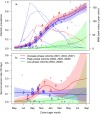Temporal dynamics of Puumala hantavirus infection in cyclic populations of bank voles
- PMID: 26887639
- PMCID: PMC4758042
- DOI: 10.1038/srep21323
Temporal dynamics of Puumala hantavirus infection in cyclic populations of bank voles
Erratum in
-
Erratum: Temporal dynamics of Puumala hantavirus infection in cyclic populations of bank voles.Sci Rep. 2016 Apr 13;6:23853. doi: 10.1038/srep23853. Sci Rep. 2016. PMID: 27072747 Free PMC article. No abstract available.
Abstract
Understanding the dynamics of zoonotic pathogens in their reservoir host populations is a prerequisite for predicting and preventing human disease epidemics. The human infection risk of Puumala hantavirus (PUUV) is highest in northern Europe, where populations of the rodent host (bank vole, Myodes glareolus) undergo cyclic fluctuations. We conducted a 7-year capture-mark-recapture study to monitor seasonal and multiannual patterns of the PUUV infection rate in bank vole populations exhibiting a 3-year density cycle. Infected bank voles were most abundant in mid-winter months during years of increasing or peak host density. Prevalence of PUUV infection in bank voles exhibited a regular, seasonal pattern reflecting the annual population turnover and accumulation of infections within each year cohort. In autumn, the PUUV transmission rate tracked increasing host abundance, suggesting a density-dependent transmission. However, prevalence of PUUV infection was similar during the increase and peak years of the density cycle despite a twofold difference in host density. This may result from the high proportion of individuals carrying maternal antibodies constraining transmission during the cycle peak years. Our exceptionally intensive and long-term dataset provides a solid basis on which to develop models to predict the dynamic public health threat posed by PUUV in northern Europe.
Figures



References
Publication types
MeSH terms
LinkOut - more resources
Full Text Sources
Other Literature Sources

